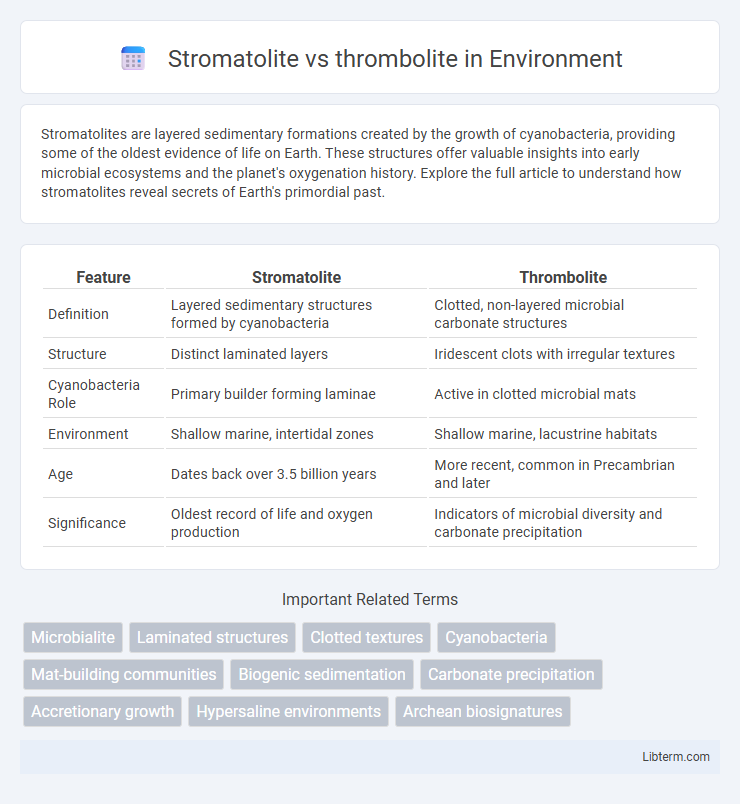Stromatolites are layered sedimentary formations created by the growth of cyanobacteria, providing some of the oldest evidence of life on Earth. These structures offer valuable insights into early microbial ecosystems and the planet's oxygenation history. Explore the full article to understand how stromatolites reveal secrets of Earth's primordial past.
Table of Comparison
| Feature | Stromatolite | Thrombolite |
|---|---|---|
| Definition | Layered sedimentary structures formed by cyanobacteria | Clotted, non-layered microbial carbonate structures |
| Structure | Distinct laminated layers | Iridescent clots with irregular textures |
| Cyanobacteria Role | Primary builder forming laminae | Active in clotted microbial mats |
| Environment | Shallow marine, intertidal zones | Shallow marine, lacustrine habitats |
| Age | Dates back over 3.5 billion years | More recent, common in Precambrian and later |
| Significance | Oldest record of life and oxygen production | Indicators of microbial diversity and carbonate precipitation |
Introduction to Stromatolites and Thrombolites
Stromatolites and thrombolites are sedimentary structures formed by the trapping, binding, and precipitation activities of microbial mats, primarily cyanobacteria. Stromatolites exhibit laminated, layered textures resulting from sequential microbial growth, while thrombolites display clotted, unlaminated internal structures caused by irregular microbial aggregation. These microbialites provide critical insights into early life on Earth, with stromatolites dating back over 3.5 billion years and thrombolites representing a more complex microbial ecosystem evolution.
Geological Definition of Stromatolites
Stromatolites are layered sedimentary formations created by the trapping, binding, and cementation of sedimentary grains by microbial mats, primarily cyanobacteria, in a laminated structure. Unlike stromatolites, thrombolites exhibit a clotted or thrombolitic texture without defined lamination, reflecting different microbial growth and sediment interaction patterns. These geological distinctions are crucial for interpreting ancient microbial ecosystems and sedimentary environments in the rock record.
Geological Definition of Thrombolites
Thrombolites are clotted microbial structures formed by the trapping, binding, and precipitation activities of microorganisms, particularly cyanobacteria, distinguished from stromatolites by their irregular, clotted texture rather than laminated, layered growth. These geological formations represent some of the oldest evidence of life on Earth, dating back to the Precambrian era, and are crucial in understanding microbialite ecosystems and early sedimentary processes. Thrombolites provide key insights into paleoenvironmental conditions and biogeochemical cycles through their unique three-dimensional fabric and microbial community interactions.
Formation Processes: Stromatolites vs Thrombolites
Stromatolites form through the layered accumulation of cyanobacteria mats trapping sediment, resulting in laminated structures, while thrombolites develop from similar microbial communities but produce clotted, non-laminated textures due to irregular mineral precipitation. Both structures represent microbialite formations, but their distinct formation processes highlight differences in microbial activity and sediment interaction. The continuous trapping and binding in stromatolites contrasts with the patchy mineralization events that characterize thrombolite growth.
Microbial Roles in Stromatolite and Thrombolite Development
Stromatolites and thrombolites are microbial carbonate structures formed by the activity of cyanobacteria and other microbes that trap and bind sediment, contributing to their distinct laminated and clotted textures, respectively. In stromatolites, microbial mats create fine, laminar layers through repeated cycles of growth and sediment trapping, while thrombolites develop a clotted texture due to irregular microbial mat growth and localized calcification processes. Microbial communities in both structures mediate carbonate precipitation through photosynthesis-driven pH changes, but variations in microbial composition and sediment dynamics influence their unique morphologies and mineralization patterns.
Structural Differences Between Stromatolites and Thrombolites
Stromatolites exhibit laminated, layered structures formed by the trapping, binding, and cementation of sedimentary grains by microbial mats, primarily cyanobacteria. Thrombolites display a clotted or peloidal texture without distinct layers, resulting from the irregular growth and aggregation of microbial communities. The key structural difference lies in the laminated stratification of stromatolites versus the clotted, non-laminated fabric of thrombolites.
Fossil Record and Evolutionary Significance
Stromatolites exhibit finely laminated microbial mats, representing some of the earliest evidence of life dating back over 3.5 billion years, which highlights their crucial role in understanding Earth's early biosphere. Thrombolites, characterized by their clotted, non-laminated structure, emerged later in the fossil record and provide insights into microbial diversity and sedimentary environments during the Proterozoic and Phanerozoic eons. Both structures contribute significantly to evolutionary studies by documenting microbial evolution and the development of early biogenic activity in sedimentary contexts.
Modern Occurrences and Habitats
Modern stromatolites primarily thrive in hypersaline environments such as Shark Bay in Australia and the Bahamas, where extreme salinity limits grazing organisms. Thrombolites are often found in freshwater to brackish aquatic settings like Lake Clifton in Western Australia, exhibiting a clotted internal structure that differs from the laminated composition of stromatolites. Both microbialites contribute to sedimentary frameworks, but their distinct microenvironments highlight diverse ecological adaptations in microbial mat communities.
Applications in Paleoenvironments and Earth History
Stromatolites and thrombolites serve as critical indicators in paleoenvironmental reconstruction, offering insights into ancient microbial ecosystems and sedimentary conditions. Stromatolites exhibit finely laminated microbial mats that provide detailed records of water chemistry and microbial activity during the Precambrian era. Thrombolites, with their clotted fabric structure, highlight variations in microbial diversity and environmental stress, aiding in the interpretation of evolutionary shifts and biogeochemical cycles in Earth's history.
Key Differences: Stromatolite vs Thrombolite Summary
Stromatolites feature laminated, layered structures formed by cyanobacteria trapping sediment, whereas thrombolites exhibit clotted, non-laminated textures resulting from irregular microbial growth. Stromatolites typically represent more stable microbial mat ecosystems, while thrombolites indicate dynamic environments with varied microbial activity. These differences in morphology and formation processes offer crucial insights into ancient microbial ecosystems and sedimentary environments.
Stromatolite Infographic

 libterm.com
libterm.com